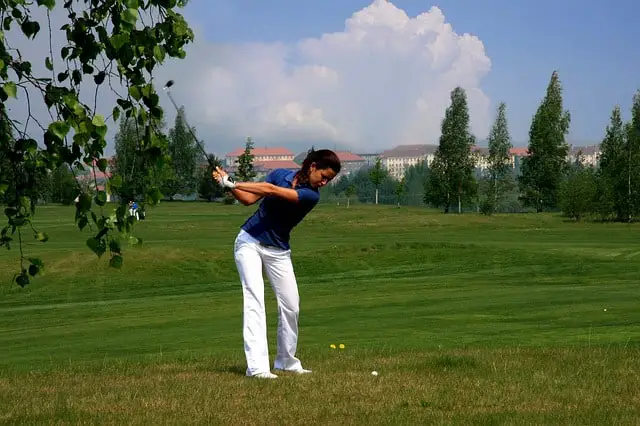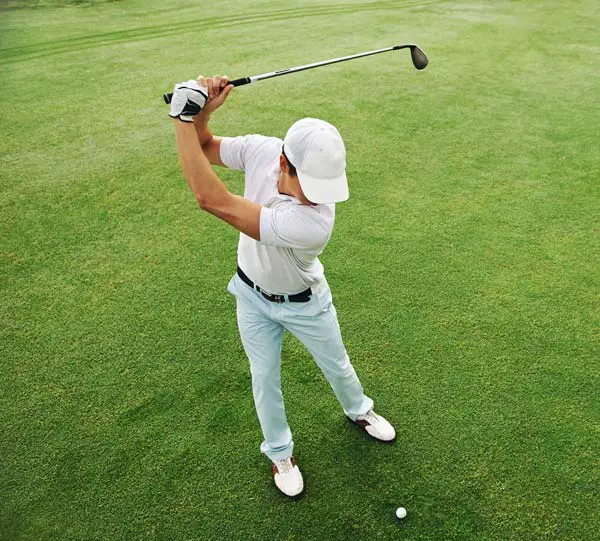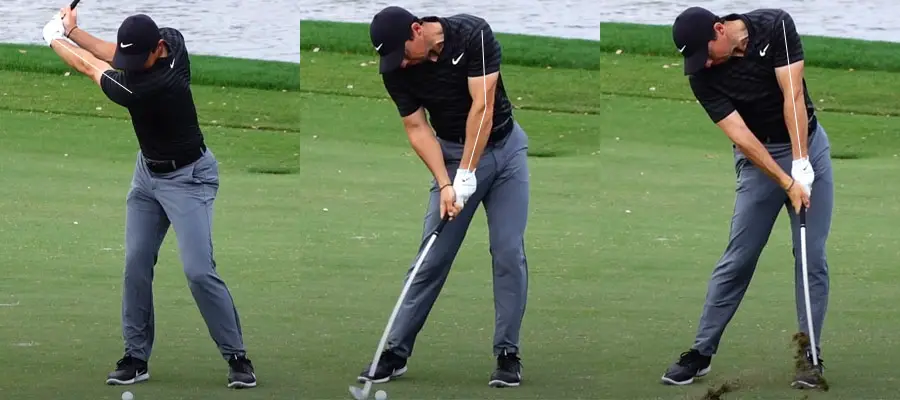There seems to be a lot of debate among golf instructors as to whether or not you should keep your left arm straight. Many of the pros seem to do it but is it something that every golfer should do?
Well in a word, no. But let me explain…
From looking at the golf swings of the top players, I think it’s clear that there isn’t a straight answer to this question (excuse the pun!). Many elite players keep their arm straight but many play with a bent left arm.

I think it’s safe to say that the classic instruction that “you must keep your left arm straight” is nonesense. In fact, trying to achieve this could be very distructive for many, if not most, golfers.
Keeping the left arm straight throughout the swing definitely demands a higher degree of flexibility. In my view, most amateur golfers and even many pros, do not have enough flexibility to achieve this without introducing tension in the swing.

And for me, that is the most important thing. I would say there’s very few golfers in the world that wouldn’t benefit from reducing tension in their swing. Tension can creep into the best golf swings and wreak havock with the swing mechanics and repeatability.
If your left arm doesn’t want to stay straight naturally then it’s for a reason. Your arm and shoulder are reaching their maximum range of motion and have to bend in order to continue moving.
Trying to keep them straight at this point will likely lead to tenison and discomfort. At best this will probably lead to slight inefficiencies in the swing and at worst, it could lead to huge inefficiencies and a complete lack of consistency.
Look at the images of JB Holmes below and notice how he allows his left arm to bend. He starts with it pretty much straight but the further he swings back, the more it flexes.

JB Holmes’ left arm is one of the more pronounced examples from the PGA tour. Like most amateur golfers, perhaps he lacks a little flexibility compared to other pros. But he plays within himself, he isn’t trying to do something that is uncomfortable.
I think his left arm move is well suited to the vast majority of golfers. But rather than copying his left arm exactly, I would recommend using the amount of left arm bend that is natural and comfortable for you. Just don’t worry about your left arm bend!
And it can’t be said that he is giving something up with this move since he is one of the best drivers of the golf ball in the world. Most pros would pay a fortune to drive the ball as well as JB! He hits the ball long and straight!
Many people try to force the left arm to stay straight, which is probably the worst thing to do. This will almost certainly lead to a large amount of tension in the swing.

Other golfers try to limit the length of their swing in order to maintain the straight left arm. While this may be a better option, it is likely robbing them of power and distance.
If you really want to keep your left arm straight the best way would be to work on your flexibility. You could then experiment with a straight left arm without introducing too much tension in your swing.
However, it is not clear that a straight left arm is a benefit to the golf swing so I find this idea difficult to recommend. Whilst improved flexibility is undoubtably advantagoues, the left arm is just one part of the golf swing.

In my view, most golfers would perform better if they didn’t worry about keeping their left arm straight. This could allow them to perform a more natural and free-flowing swing, with less tension and conscious thought. After all, there are few things worse for a golf swing than a stiff body and a cluttered mind.
The left arm doesn’t actually tend to “stay straight” in the downswing as many people believe. In fact, the left arm tends to straighten in the downswing. What this implies is that the left arm wasn’t straight to begin with.
And this is typically true. There are very few golfers, even elite golfers, that have a perfectly straight left arm throughout the backswing. The left arm is generally somewhat flexed, or “soft” as the backswing starts to change direction.

Even the golfers who appear to have a straight arm rarely do when you view their swing in slow motion.
Take a look at the images of Tiger below. Even though he appears to have a “straight arm”, we can see that there is a slight flex in the backswing transition and the arm straightens out just after impact.

As the body rotates during the downswing, this creates centripital forces that throw the arms outwards. This force causes the left arm to straighten naturally.
So the golfer doesn’t need to think about keeping the left arm straight at all. Proper rotation and good timing allows the move to take care of itself. This helps to generate speed and that feeling of effortless power that we’re all looking for.
However, the left arm still doesn’t usually straighten completely. And nor does it have to. It simply straightens more than it was in the backswing. Since the golfer isn’t actively trying to straighten it, there is little chance that it will straighten beyond it’s natural range of motion.
Just as the top golfers in the world have different left arms during the backswing and downswing, the same is true at impact. So I think it’s impossible to say that one way will work for every golfer.
Having said that, there are very few world class golfers that have a straight left arm at impact. Even golfers that play with a “straight left arm” tend to have some degree of flexion at impact. A completely straight arm is unnatural and introduces tension and instability at impact.
Take the images of Rory Mcilroy below, for example. Notice how his left arm is fully extended during the backswing and followthrough. But notice that at impact the arm is not fully extended, is it slightly flexed.

Watching Mcilroy’s swing at full speed (and boy it’s fast!), it’s easy to think that his left arm remains straight throughout his swing, including at impact. But looking at the stills closely, we can see that his left arm actually flexes at the start of the downswing and then straightens just after impact, into the followthrough.
But at impact itself, his left arm is not straight, it is definitely flexed. And this makes sense. A flexed left arm is generally more relaxed and stable, absorbing the impact and guiding the club comfortably through the ball.
You can tell that he’s almost certainly worked on keeping his left arm straight as much as possible. But how much this has helped him is difficult to say. In fact, it could be argued that it’s made the swing more complex than it needs to be.
A simpler motion would probably be to allow his left arm to be flexed slightly in the backswing and then allow it to straighten naturally on the throughswing. Instead, because his arm is so straight during the backswing, it has to soften at the start of the downswing (in transition) in order that it can be flexed at impact, which he can then allow to straighten again on the followthrough.
But of course, Mcilroy is so flexible and talented that he can make this move work. And work it does! But how many other golfers can replicate this move?! I don’t there’s many.
Most professional golfers address the ball with a straight left arm, or at least very close to straight. But, if the lead arm doesn’t have to be straight during the swing, does it have to be straight at address?

I would say that it doesn’t have to be straight. I think being tension free at address is more important. If a straight left arm feels relaxed and comfortable that’s fine. But if there’s tension, maybe some flex in the left arm could help. We’re not all built like Tiger!
A tension free followthrough starts with a tension free downswing. A tension free downswing starts with a tension free backswing. And a tension free backswing starts with a tension free address position. So being relaxed and comfortable over the ball is more important, in my view.
A chicken wing in golf is where the left arm is bent through impact and especially into the followthrough. It’s not something you cook on a BBQ! Classic golf tuition tells us that it’s a bad move. But as we’ve seen, most pros have a slightly bent left arm at impact.

However, their arms tend to straighten after impact, which is an indication that they have freely realeased the club. So a bent left arm into the followthrough may indicate that the golfer is trying to steer the shot as opposed to allowing the club to swing.
Having said that, some amount of chicken wing is probably fine. This all depends on the individual and I don’t think it’s fair to say that all chicken wings are bad (they’re certainly tasty!).
Take a long at Long Drive Champion Jamie Sadlowski below. Does he have a chicken wing?! If so, we should consider that maybe they’re a good thing? He hits the ball 400 yards!

This action can actually lead to a more stable club through impact. The club is not rolling over, making the shot difficult to time. In Sadlowski’s case, the chicken wing helps him to keep the clubface square. It making errant shots, especially hooks, less likely.
Watch the slow motion video of Jamie Sadlowski hitting his long driver below. It’s an incredible golf swing!
Additionally, the chicken wing can help to control the loft, eliminating the high “flippy” shot. This is a shot that many amateurs struggle with. It is easy to add loft to the club at impact, leading to the high spinny shot that loses distance.
Golfers that don’t normally play with a chicken wing can actually benefit from it in certain conditions. It can be useful in thick rough or in a bunker where it is very important to prevent the clubface from rolling over.

I think the old golfing adage that the chicken wing is bad has had it’s time. Using high speed cameras, we can find many extremely skilled golfers that have a chicken wing in their swing. Jordan Spieth is another great example.
In general, the arms should extend in the follow through as a result of the golfer swinging the weight of the club. The centripetal force created by the rotation of the body pulls the arms into the follow through.

This is similar to throwing a ball. Our arm bends as we turn our body and take the ball back, and straightens as we turn our body on the way through. The golf swing works by the same principal.
Many golfers lack commitment through the ball and tense up. This could be because they are afraid of the outcome or they are trying to steer the ball. The tension often leads to a poor shot. A weak follow through is just an indication of what has happened.

A lack of follow through can also be an indication of poor body rotation. The golfer may be trying to hit the ball with their arms as opposed to staying relaxed and allowing the turn of the body to propel the club into the ball.
In conclusion, I think it’s safe to say that a straight left arm is not crucial to a good good swing. Having looked at the swings of top tour players, it’s clear that many of them play with a bent left arm.

Most professionals have a fairly straight left arm at address. But most of them play with a lead arm that is slightly bent in transition and at impact. The left arm tends to straighten out after impact, but not always.
Given that playing with a straight lead arm requires a great deal of flexibility, I don’t think it would suit most amateur golfers. I think the majority of golfers would do better by focusing on swinging as relaxed and tension free as poossible, allowing the left arm to flex naturally.

I think the straight left arm is another aspect of the classic one-size-fits-all approach of classic golf instruction. Personally, I think it’s a myth (we’ve seen most pros don’t do it!). Everybody has a different build, level of flexibility, and natural swing. What works for one golfer may not work for another.
So I would recommend focusing on what works for your swing and your body. Do what feels natural and easy. The golf swing should be smooth and tension free, not rigid and uncomfortable.
Now let’s get to the range!

I’m Tom Rothwell and I’m a 3 handicaper that's obsessed with golf. You can often find me hitting balls on a driving range somewhere!
I'm on a journey to learn as much as possible about the great game. I've made Clean Strike Golf to share everything I discover along the way.